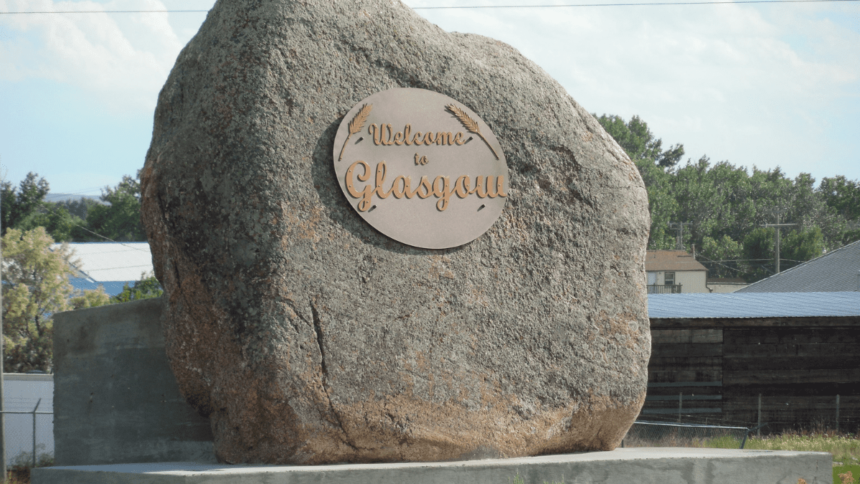When families, hospitals, and other nursing homes call Wes Thompson to see if he can take new patients, his instinct is to try and help.
The senior care home he runs in Glasgow, Valley View Home, is licensed for 96 beds and includes a secure unit for patients with dementia. The walls are adorned with decorations and typed memos about patient safety. Residents walk the carpeted, air-conditioned halls or sit in small groups, chatting with staff or watching television.
And there’s plenty of room for more people. Thompson’s daily average of residents hovers around 48. That figure is unsustainably low, and far lower than Valley View’s pre-pandemic golden era, when the facility had enough staff to care for more than 70 people at a time — and the facility was able to stay afloat.
Credit: Mara Silvers / MTFP
“We’re going to do it again,” said Thompson, 47. “And every month, we try harder.”
Valley View’s small number of patients can be partly attributed to Glasgow’s size and remoteness. The town proudly claims the “middle of nowhere” label bestowed by the Washington Post in 2018. Its population, which has generally been trending down for decades, was 3,192 in 2022.
Thompson also has to contend with the area’s stubbornly independent culture. Many seniors prefer to age in their own homes for as long as possible, he said.
But when prospective patients do come knocking, Thompson’s facility isn’t the right fit for everyone — especially those with advanced clinical needs. Valley View doesn’t have higher-salary physical or occupational therapists on staff to help with patient rehabilitation. Admitting more patients would also require hiring more certified nursing assistants and registered nurses — health care professionals that are hard to recruit in small towns. And when ailing residents have to travel beyond Glasgow for doctor appointments — sometimes more than four hours one way to Billings or Great Falls — Valley View has to find staff to go with them.
“This is a home-like environment and we only have so many staff members,” said Emilee Poole, the facility’s director of nursing. “If we’re taking all these high-acuity residents, it’s not fair to them. Right? Because we can’t provide them the highest level of care.”

Credit: Mara Silvers / MTFP
The situation, emblematic of deeply entrenched issues facing Montana’s rural nursing homes, is just one example of a Valley View catch-22: The facility can’t take on more patients without also growing its qualified staff. But hiring more staff at increasingly competitive wages is impossible without generating more patient revenue. And without a consistently higher threshold of residents — somewhere between 60 and 70, Valley View officials estimate — the facility is far from financially sustainable.
The future of Valley View Home is on the minds of Glasgow locals, too.
“That home is so important,” said Paul Tweten, Valley County Commissioner. “Without it, I don’t know where the people would go.”
Thompson, a fast-talking administrator with a blunt delivery and a quick recall for statistics, often emphasizes Valley View’s resiliency. It kept its doors open through the desperate times of the COVID-19 pandemic with the help of federal grants, local levies, and about a million dollars from Valley County’s pool of federal relief funds. Board member Mary Armstrong also recalled an all-hands-on-deck mentality among Valley View’s team, with Thompson occasionally taking over as head chef when kitchen staff were out sick.

Credit: Mara SIlvers / MTFP
The pandemic left many of Montana’s elder care facilities shaken and financially unstable. Thompson was a vocal participant in the 2023 Legislature, where he lobbied lawmakers to increase reimbursement rates for Medicaid, which covers most of Valley View’s patients. By the end of the legislative session, the Republican-led House and Senate voted to increase the bed rate for Medicaid residents to about $280 a day — a historic 30% boost.
“Certainly a 30% bump on the Medicaid rates helps us go out of business more slowly. I’ve looked at this up, down and sideways. Without the county continuing to pay to keep that nursing home open, it’s just not a model that will have economic success over the long term.”
Valley County Commissioner Mary Armstrong
Provider and patient advocates said that increase was essential, but they argue it still doesn’t cover the true cost of providing care when factoring in inflation, filling positions with expensive traveling contract staffers, and the costs required to keep up with ever-changing state and federal regulations.
“Certainly a 30% bump on the Medicaid rates helps us go out of business more slowly,” said Armstrong, a Valley County commissioner whose mother lived at Valley View years ago. “I’ve looked at this up, down and sideways. Without the county continuing to pay to keep that nursing home open, it’s just not a model that will have economic success over the long term.”
Thompson argues that much of the financial strain on the facility would be remedied if Montana Medicaid paid providers close to what it actually costs to care for low-income nursing home residents — somewhere between $360 and more than $400 a day.
Nursing home officials don’t expect a warm reception from state lawmakers if they ask for more Medicaid rate increases during the next Legislature. But Thompson and others say such increases are critical when most of their patients are covered by Medicaid and private payers are in the minority.
Historically, fiscally conservative state officials have been reticent to significantly increase Medicaid reimbursement for senior and long-term care. The reasoning varies: Some don’t believe in growing a government subsidy. Others contend that nursing homes were never meant to be made solvent by Medicaid. Instead, they see the program as a supplement for facilities that primarily rely on patients who pay out of pocket or through private insurance plans.
But even local politicians who subscribe to that perspective struggle with the logic when a rural nursing home closes. In a recent interview, Sen. Mike Lang, R-Malta, fretted about the growing role of government in elder care and the need for individuals to stay healthy and take care of themselves. But in 2023, a year after the retirement home in his town closed, Lang was one of the lawmakers who pushed for higher Medicaid reimbursement rates over opposition from some of his Republican colleagues.
“All of us want to take care of the people,” Lang said. If his own parents were still alive and in need of care, he continued, “I would rather have them here living in a rest home than somewhere else. But that all takes money.”

Credit: Mara Silvers / MTFP
The Montana Health Care Foundation, which represents senior and long-term care facilities, has said that the state’s Medicaid reimbursements should acknowledge the “astronomical cost increases” coming from “wages, contract labor, inflation and regulations.” The pandemic thrust health care facilities and nursing homes into a new era, advocates contend. The fundamental calculations for how to stay open have changed.
Thompson is relieved that Valley View’s reliance on contract staffing, which bled health care budgets throughout the pandemic, is slowly decreasing. His current budget for traveling staff is $80,000 a month, down from the runaway costs of $220,000 a few years ago. In June, he did better than expected, paying out only about $65,000.
“We’re able to retain more staff and more staff are happy,” Thompson said. By not taking on more patients than his employees can safely handle, he added, he hopes to avoid burnout and make sure workers “never feel alone” when caring for residents.
Sometimes, Thompson expresses a rugged optimism about his facility’s ability to stabilize its budget and make ends meet long-term. 2022 was the rare year when Valley View Home, a nonprofit, reported bringing in more than it spent — a net income of $1.5 million, according to the facility’s public tax records. In almost every other year since Thompson took the job in 2018, the facility reported a negative net income of hundreds of thousands of dollars.

Credit: Mara Silvers / MTFP
Still, Thompson and others rooting for Valley View Home express the persistent feeling that many decision makers in Helena don’t understand or care about the unique challenges and needs of rural health facilities. In the first few years of the pandemic, some nursing home operators felt snubbed by Gov. Greg Gianforte’s handling of federal relief funds. The 2023 fight over Medicaid rates deepened the perception among advocates of a disconnect with the governor’s office. Tensions between the state health department and nursing home lobbyists continued to simmer at public meetings as recently as this month.
From Armstrong’s perspective, ever-increasing regulations from state and federal authorities often feel like unfunded mandates. Rarely, they say, does it seem like government is trying to help nursing homes succeed.
“We’re trying to keep these people alive,” Armstrong reflected, particularly regarding the pandemic era. But interactions with regulators, she recalled, felt “like a Dilbert cartoon.”
Ultimately, Armstrong expressed disappointment about the “us versus them” climate she perceives between nursing home operators, lawmakers, and state and federal officials. For rural communities, she continued, the future of senior care systems couldn’t be more of a collective problem.
“It’s just one more nail in the coffin of rural communities,” Armstrong said. “If we don’t have places for our old people, who paid their taxes and built their communities … that is tragic.”
LATEST STORIES
NorthWestern to acquire Energy West in $39M deal
NorthWestern Energy expects to complete the $39 million purchase by the first quarter of 2025, though it’s subject to approval by the Montana Public Service Commission, according to a press release.
‘A forgotten history,’ remembered
At least 973 Native American children died in the U.S. government’s abusive boarding school system, according to the results of a newly completed investigation by officials who called on the government to apologize for the schools.
75 years after fatal Mann Gulch Fire, families to gather to remember fallen smokejumpers
A series of events in Helena will mark 75 years since the Mann Gulch Fire, the single deadliest day in the history of smokejumping. The fire inspired Norman Maclean’s award-winning book, “Young Men and Fire,” but more importantly it had a profound impact on how wildfires are managed and fought.





